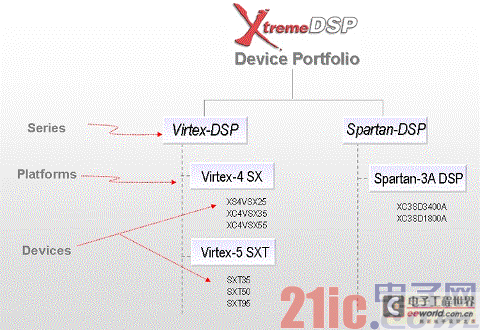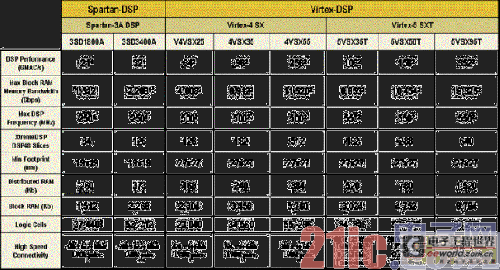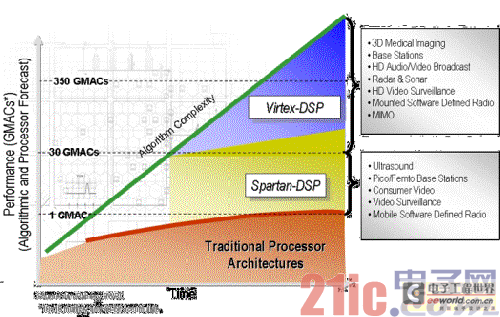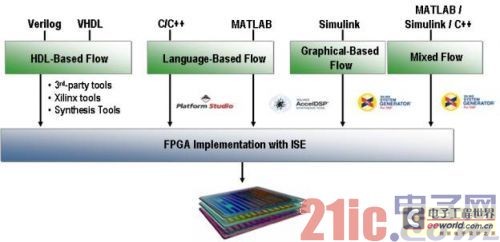It is no accident that Xilinx FPGA products play an increasingly important role in the design and development of today's most demanding digital signal processing (DSP) systems. After more than two decades of research and engineering development, as well as close collaboration with hundreds of DSP customers, Xilinx FPGA products have evolved into high-value DSP solution platforms that have achieved extremely high levels of performance, flexibility, time to market, and product life, while also significantly reducing overall system cost and power consumption.
As we all know, FPGAs can use highly parallel structures to complete complex algorithms in a single clock cycle. Current FPGAs can provide hundreds of thousands of operations per second (MSPS) and billions of multiplication and accumulation operations per second (GMACS) in a single device. With such a high level of DSP performance, designers can choose to reduce the clock rate of the FPGA to save power, or they can choose to implement more channels to reduce system cost and reduce bill of materials cost (BOM).
Nevertheless, FPGA solutions not only have such great cost/performance advantages, but also the value in flexibility, time to market and product life is also very attractive. The fast-growing markets with high demand for high-performance DSP technology, including communications, multimedia, video and imaging (MVI) and defense industries, are in rapid change. The ever-changing standards, market demands and customer requirements, the rapidly changing economic situation and competitive situation have brought huge business opportunities to companies that can keep up with the pace of change through innovation and flexibility. For more and more system designers and DSP designers, FPGA has become the platform of choice.
Xilinx XtremeDSP Program In November 2000, Xilinx launched the XtremeDSP™ program, which aims to provide an evolving, application-optimized DSP solution product line to meet the needs of the communications, multimedia, video and imaging, and defense industries for high-performance DSPs. Its top priorities include:
· Continue to expand the product line of high-performance devices for DSP design
Provide development boards and kits, reference designs and IP
Launch of design and development tools for different DSP system design methodologies
Provides complementary programmable logic, connectivity and embedded processing capabilities
· Build strategic partnerships with industry and universities to provide training and support
Highest performance and flexibility
Performance, system-level cost and power efficiency, faster time to market, and flexibility are the hallmarks of FPGA-based DSP design. All of these value advantages are urgently needed by leading manufacturers in industries such as communications.
The global demand for higher quality, greater bandwidth and lower cost wired and wireless voice, computer and video data communications is unprecedented. Driven by this, the number and complexity of new communication standards are increasing at an exponential rate. This is largely due to the need to achieve interoperability and data exchange between the many communication layers in traditional and next-generation networks. In addition, the increasing demand for new services delivered wirelessly is also an important reason driving today's standards development boom. For system vendors, it is not easy to keep up with the evolution of these standards and meet the extremely critical performance-price-power requirements.
For the dynamic markets served by high-performance DSP solutions, the flexibility of FPGAs means:
Higher levels of integration to reduce system costs
Leading algorithm solutions and standards implementation support faster time to market, which can significantly increase market share
Remote adjustment is easy to operate and can adapt to unpredictable environment and functional changes (thus reducing operating costs)
Extend the lifecycle of existing designs (thus reducing capital expenditures)
· A perfect platform for innovative product design and migration to keep pace with changing customer needs and market requirements.
XtremeDSP Device Product Line
The XtremeDSP product line includes Virtex™-DSP and Spartan-DSP series products, which provide a rich combination of price, performance, power efficiency, bandwidth and IO to meet a wide range of application requirements. Virtex-5 SXT and Spartan-3A DSP products are the latest additions.

Figure 1. XtremeDSP device product line
Virtex-5 SXT – Highest Performance and Connectivity
The Virtex-5 SXT platform further expands Xilinx's XtremeDSP™ product line with three new devices that meet the ultra-high DSP bandwidth and lower system cost requirements for next-generation wireless, defense, and multimedia, video and imaging applications. SXT is the third of four 65nm Virtex-5 FPGA platforms. With the introduction of the SXT platform, Xilinx FPGAs now offer more than 350 GMACS of DSP performance at 550MHz clock while reducing dynamic power consumption by 35% compared to the previous 90nm generation. The Virtex-5 SXT platform is also the industry's first DSP-optimized FPGA family to offer serial connectivity through low-power transceivers (up to 3.2 Gbps).
In addition to leveraging 65nm ExpressFabric™ technology to increase logic performance, all Virtex-5 FPGAs integrate user-configurable DSP48E slices. The DSP48E slices are a new evolution of the multiply-accumulate (MAC) functional block. These DSP engines can perform MAC operations at frequencies up to 550 MHz. FPGAs enable highly parallel architectures that increase DSP performance by more than two orders of magnitude over discrete DSP processors, while minimizing cost and power per channel.
Virtex-5 SXT devices range in logic density from 35,000 to 95,000 logic cells, while the number of dedicated DSP48E slices ranges from 192 to 640. Integrating up to 11.6 Mbits of embedded BlockRAM and distributed RAM, these devices offer the highest memory-to-logic resource ratio to efficiently implement memory-intensive functions required by DSP applications in the video processing and medical imaging markets.
The Virtex-5 SXT platform also integrates low-power RocketIO™ GTP transceivers (typically <100mW @ 3.2 Gbps) and PCI Express® endpoint and Ethernet MAC modules built into the Virtex-5 LXT platform for the first time. Both platforms support all major serial I/O protocols (PCIe™, CPRI, OBSAI, SRIO, GbE, and XAUI), providing the lowest power solution for high-speed, high-bandwidth connections between chips, boards, and chassis.
Spartan-3A DSP Platform – Breakthrough Price/Performance
In the process of seeking the best DSP solution for a specific application, designers usually have to make a lot of trade-offs between price, performance and power consumption, usually sacrificing one or more performances to meet the requirements of other aspects. The Spartan-3A DSP platform is another new member of the Xilinx XtremeDSP product line, and it is also the first Spartan FPGA series product optimized for DSP. The Spartan-3A DSP perfectly combines these three key performances and provides the best combination for a large number of applications.
Signal processing capacity
The Spartan-3A DSP platform is priced at less than $30 per unit in mass production, providing more than 30 GMACS of DSP performance and up to 2,200 Gbps of memory bandwidth in a small package. This represents an unprecedented performance/price breakthrough that meets the requirements of a large number of price- and power-sensitive applications. These applications include digital head-end (DFE) and baseband solutions in single-channel micro-cell wireless base stations, military mobile software-defined radio (SDR), ultrasound systems, assisted driving/multimedia systems, high-resolution (HD) video, and smart IP cameras. [page]
Moreover, with up to 53,712 logic cells, 2,268 Kb BlockRAM, 373 Kb distributed RAM, 519 I/O pins, DeviceDNA security technology and new sleep/standby power management functions, Spartan-3A DSP devices provide sufficient signal processing capacity to reduce the price/performance/power consumption ratio to a lower level. In addition, the design flexibility and fast time to market provided by FPGA-based DSP solutions further reduce risks, so the value of the Spartan-DSP series becomes increasingly obvious (see Table 1).

Table 1: The Spartan-DSP platform fills the 1-30 GMACS performance range in the XtremeDSP product line.
Note: 1) In low speed devices. 2) In high speed devices
Pushing DSP performance to the limit
The most important market driver for the use of FPGAs in DSP applications is the rapid increase in algorithmic complexity over the past two decades. The problem faced by fixed-architecture processors such as DSPs and general-purpose processors (GPPs) is that inherent architectural inefficiencies limit their performance to below the theoretical limit imposed by Moore's Law.
In addition, as communication systems continue to push data transmission efficiency to the upper limit of Shannon's Law (see Figure 2), advanced technologies such as Reed-Solomon coding and the recent Turbo code are getting closer and closer to their theoretical limits, of course, at the cost of higher computational complexity. This has led to a growing gap between algorithm performance requirements and processor performance. Therefore, designers must look for new design solutions (not limited to the traditional DSP range) and choose FPGAs outside of fixed-structure processors.

Figure 2. Xilinx FPGAs fill the performance gap created by algorithm complexity and the ineffectiveness of fixed-architecture processors.
FPGA parallel processing mechanism can provide extremely high-performance signal processing capabilities, so it is very suitable to fill this performance gap. FPGA flexible architecture makes it easy to migrate designs between similar series devices, thus minimizing the risk of changes in standards or even environmental conditions.
DSP48E logic chip
One of the most valuable resources in all devices in the XtremeDSP product line is the DSP48 logic slice, which not only helps improve the overall performance of DSP designs, but also improves the design and resource efficiency to achieve the required performance. The DSP48 is an application-oriented combinational module (ASMBL™) that enhances the DSP functions in Virtex-DSP and Spartan-DSP devices. These DSP49 logic slices can help DSP designers design solutions to meet complex challenges, such as: hundreds of IF-to-baseband down-conversion channels, 128X chip rate processing in 3G spread spectrum systems, and high-resolution H.264 and MPEG-4 encoding/decoding algorithms.
A DSP48 basic slice (also called an XtremeDSP basic slice) contains two DSP48 logic slices, forming the basis of a general coarse-grained DSP architecture. The DSP48 logic slice supports a variety of independent functions, including multipliers, multiplier-accumulators (MACCs), adder multipliers, three-terminal input adders, barrel shift registers, wide bus multiplexers, amplitude comparators, or wide input adders. Without the need to use general programmable logic construction resources, this architecture supports connecting multiple DSP48 logic slices to complete wider input digital functions, DSP filters, and complex algorithms. This can bring lower power consumption, extremely high performance, and higher chip resource utilization efficiency.
Another important benefit brought by DSP logic slices is the portability from one platform family to another, for example, from Virtex-4 SX or Virtex-5 SXT devices to Spartan-3A DSP devices. Since DSP48 is the basic DSP building block of Virtex-DSP and Spartan-DSP families, porting from one family to another is a very direct process with minimal design changes.
XtremeDSP Design Tools
Through the XtremeDSP program, Xilinx and its third-party partners have reached a consensus in the industry ecosystem to provide all the potential and flexibility of DSP to three different design groups as conveniently as possible: system designers, DSP engineers, and FPGA/hardware engineers. Each type of designer has different responsibilities (and preferences), which leads to different requirements for their specific design environment.
System designers must quickly determine how to best partition different system-level functions among the available processing resources. Their focus is on selecting processing resources that meet the product's performance and throughput requirements while meeting size, cost, and power budgets.

Figure 3. XtremeDSP design tools meet the design environment requirements (preferences) of all three design user groups—system designers, DSP engineers, and FPGA/hardware engineers.
DSP engineers are more concerned with the creation and improvement of DSP algorithms. They are usually unfamiliar with hardware design details and rely on tools to abstract away the details so that they can focus more on higher-level design exploration and verification.
Hardware engineers typically use VHDL or Verilog to get the highest performance from their designs. They need the ability to work with higher-level functional blocks and their own register transfer level (RTL) designs in the same design environment, and can run test benches for functional and performance verification.
Therefore, a key indicator of the success of the XtremeDSP program is the degree to which the design tools meet all three types of design groups. XtremeDSP tools, such as SystemGenerator for DSP and AccelDSP™ comprehensive software, provide system modeling, algorithm development and exploration, automatic generation of test benchmark vectors, design verification and debugging, and HDL generation and simulation. Whether a designer prefers to use VHDL, Verilog, C/C++, MATLAB, Simulink and HDL, or any combination of these tools, Xilinx's XtremeDSP tools can help him/her quickly and efficiently realize the full potential of FPGAs (see Figure 3).
in conclusion
FPGAs fill the huge and growing gap between the demand for high-performance DSPs in high-performance applications and the performance that traditional DSP processors can provide. There are many reasons that motivate designers to adopt FPGA-based DSP solutions, and the four most basic reasons are summarized as follows:
1. Handling extremely high computational workloads - FPGAs allow engineers to design highly parallel architectures, thus supporting sampling rates that are the same as the clock frequency. The system can therefore maintain high performance levels up to 500MSPS – suitable for building ultra-high-speed single-channel systems or slower systems with hundreds of channels.
2. Offload computationally intensive tasks from the DSP processor, freeing up valuable execution cycles for other functions.
3. Customize the architecture for a specific algorithm - FPGAs offer a range of MACs or multipliers that can be used to implement single-tap or multi-tap algorithm architectures. The reconfigurable nature of FPGAs means engineers can quickly build and modify design architectures.
4. Reduced System Cost and Power - FPGAs allow for integration of other components (such as Serial RapidIO transceivers, PCI Express interfaces, glue logic, and low-rate control tasks), thereby reducing overall system cost and power. In addition, parallelism provides an order of magnitude to several orders of magnitude performance advantage over traditional DSP devices, allowing for the same performance to be achieved at lower frequencies. Lower frequencies reduce MOPS/mW, the most critical metric for power efficiency. As demonstrated by Professor Bob Brodersen of the Department of Electrical Engineering and Computer Science at the University of California, Berkeley, FPGAs can be up to 1000 times more power efficient than today's benchmark microprocessors. (See Bob Broderson's presentation slides)
Since its launch, the Xilinx XtremeDSP program has launched a series of application-optimized DSP solutions that combine dedicated hardware platforms, design tools, reference designs, system-level application knowledge, software algorithms, and IP libraries. These XtremeDSP solutions provide such a powerful design platform and environment that can provide DSP designs with performance close to the limit for communications, multimedia, video and imaging, and defense applications.
Previous article:Multi-core DSP in digital applications
Next article:Improved decoding algorithm for irregular LDPC codes and its DSP implementation
- Popular Resources
- Popular amplifiers
- Huawei's Strategic Department Director Gai Gang: The cumulative installed base of open source Euler operating system exceeds 10 million sets
- Analysis of the application of several common contact parts in high-voltage connectors of new energy vehicles
- Wiring harness durability test and contact voltage drop test method
- Sn-doped CuO nanostructure-based ethanol gas sensor for real-time drunk driving detection in vehicles
- Design considerations for automotive battery wiring harness
- Do you know all the various motors commonly used in automotive electronics?
- What are the functions of the Internet of Vehicles? What are the uses and benefits of the Internet of Vehicles?
- Power Inverter - A critical safety system for electric vehicles
- Analysis of the information security mechanism of AUTOSAR, the automotive embedded software framework
 Professor at Beihang University, dedicated to promoting microcontrollers and embedded systems for over 20 years.
Professor at Beihang University, dedicated to promoting microcontrollers and embedded systems for over 20 years.
- Innolux's intelligent steer-by-wire solution makes cars smarter and safer
- 8051 MCU - Parity Check
- How to efficiently balance the sensitivity of tactile sensing interfaces
- What should I do if the servo motor shakes? What causes the servo motor to shake quickly?
- 【Brushless Motor】Analysis of three-phase BLDC motor and sharing of two popular development boards
- Midea Industrial Technology's subsidiaries Clou Electronics and Hekang New Energy jointly appeared at the Munich Battery Energy Storage Exhibition and Solar Energy Exhibition
- Guoxin Sichen | Application of ferroelectric memory PB85RS2MC in power battery management, with a capacity of 2M
- Analysis of common faults of frequency converter
- In a head-on competition with Qualcomm, what kind of cockpit products has Intel come up with?
- Dalian Rongke's all-vanadium liquid flow battery energy storage equipment industrialization project has entered the sprint stage before production
- Allegro MicroSystems Introduces Advanced Magnetic and Inductive Position Sensing Solutions at Electronica 2024
- Car key in the left hand, liveness detection radar in the right hand, UWB is imperative for cars!
- After a decade of rapid development, domestic CIS has entered the market
- Aegis Dagger Battery + Thor EM-i Super Hybrid, Geely New Energy has thrown out two "king bombs"
- A brief discussion on functional safety - fault, error, and failure
- In the smart car 2.0 cycle, these core industry chains are facing major opportunities!
- Rambus Launches Industry's First HBM 4 Controller IP: What Are the Technical Details Behind It?
- The United States and Japan are developing new batteries. CATL faces challenges? How should China's new energy battery industry respond?
- Murata launches high-precision 6-axis inertial sensor for automobiles
- Ford patents pre-charge alarm to help save costs and respond to emergencies
- Looking for part-time job,
- Cumulative error analysis and clock frequency optimization for UART communication in MSP430FR2311
- Learn 3D visualization from scratch: Exploded diagram
- 1000m WIFI amplifier ~ Anyone interested?
- FilterSolutions User's Guide The simulated filter that has been practiced is pretty good
- What is the definition of these so-called self-organizing networks?
- dsp6657 serial port learning
- Try the data visualization tool of visionseed in Ubuntu
- Help with AD9 package design
- 1. Unboxing and Review

 Accurate Level-crossing ADC Design for Biomedical Acquisition
Accurate Level-crossing ADC Design for Biomedical Acquisition















 京公网安备 11010802033920号
京公网安备 11010802033920号